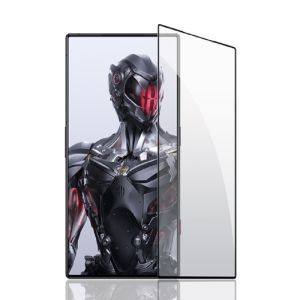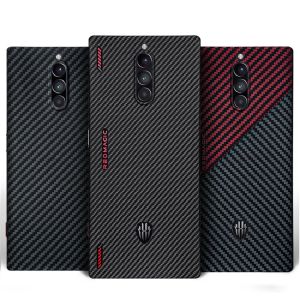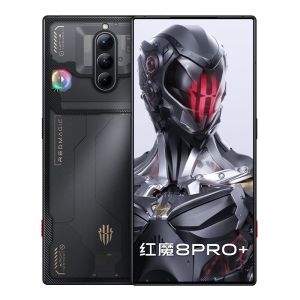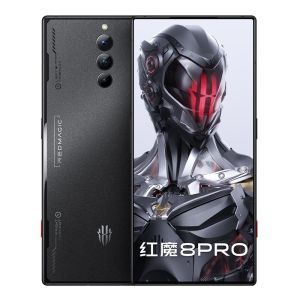The Red Magic 8 Pro features a new square design, a new Red Magic logo, and improvements in several key areas, such as a display that is now higher resolution and brighter, and a 6,000 mAh battery with more capacity.
Everything about the Red Magic 8 Pro is designed around one purpose - gaming. From the improved internal cooling system to the dedicated Red Core 2 gaming chip.
The top-of-the-line Pro+ model has an impressive 165W peak charge rate and a smaller 5,000 mAh battery to accommodate it. It's the only variant with a transparent back cover and RGB lights on the internal fan, up to 16GB of RAM and 1TB of storage. We have the Red Magic 8 Pro with a 6,000 mAh battery and a matte black finish on the back.
The nubia Red Magic 8 Pro comes in a standard two-piece cardboard box. It's thick, sturdy, and features a metallic finish and nice silver accents. We really like the geometric shape and overall color scheme. The inside of the box is scattered with various "gamer" graphics and drawings.
In terms of accessories, our device comes with a very compact 65W PD+PPS USB Type-C GaN charger and a thick red Type-C to Type-C cable in the box.
There is also a clear hard case for the phone in the box. The case doesn't really cover most of the sides of the device, but is still considered an added bonus.
Nubia chose a truly square silhouette for the Red Magic 8 Pro. Gone are the softer, more rounded edges of its predecessor. Instead, the 8 Pro looks almost "boxy". Because it still looks modern, and it does a good job of fulfilling the "gamer" aesthetic.
The Red Magic 8 Pro+ is available in the so-called "void" color scheme, with an almost transparent back. However, our regular 8 Pro unit only comes with a matte back cover. It feels silky smooth to the touch and doesn't leave too much grease or fingerprints, which is a plus.
The back is scattered with a number of "gamer" graphics and text. These look and feel are embossed on top of the surface. Nubia calls them "inlaid holographic textures", which sounds good.
The Red Magic 8 Pro has no RGB lighting around the fans. You can't even see the internal fan like you can on the transparent Pro+.
Nonetheless, the phone has some RGB lights. The REDMAGIC text and label below the two capacitive shoulder buttons lights up. Nubia calls this "RGB band lighting".
The system has 16.8 million colors and 4096 levels of brightness. There are plenty of available lighting customizations, including the ability to synchronize lighting effects with sound.
Speaking of the REDMAGIC lettering on the back of the nubia 8 Pro, sharp-eyed peeps may have noticed that nubia has done a small redesign of the logo. The new style should be bolder and have thicker lines. Nubia has also limited the use of red in its branding, although the color is still present as an accent everywhere.
The front of the Red Magic 8 Pro is all business style. Nubia has done a great job of extending the display and minimizing the bezels. The design is almost truly bezel-less, with a 93.7% screen-to-body ratio.
There are no distractions in the display either. There are no notches or perforations. Instead, Nubia worked closely with BOE to introduce a second-generation under-screen selfie camera solution. It looks really good. The camera is almost completely hidden and almost invisible in real-world use.
The Red Magic 8 Pro feels very sturdy and well-made, with almost no flex. It features a standard three-piece construction and an aircraft-grade aluminum center frame for added strength.
The front and back of the phone are made of glass. Gorilla Glass 5 on the front, to be exact, and an undisclosed type of glass on the back. In fact, the review materials are sometimes even more vague about the material of the back cover, calling it a "metal composite" back cover, which could very well be true. In any case, the back of the phone feels sturdy and the finish is good, without leaving too much grease or smudges.
Although the Red Magic 8 Pro has a rubber gasket on the SIM tray, the phone doesn't have any official protection rating. We can't imagine that an open cavity using the internal cooling fan is possible in the first place, and would certainly avoid submerging the phone in water for the same reason.
The Red Magic 8 Pro has a very non-standard and interesting set of controls and hardware scattered all over the phone. Starting on the left side, the phone has an entry point for the internal air cooling system. Directly below that is the standard volume rocker. These feel great in your hand and are well placed.
The right side of the Red Magic 8 Pro is fitted with a power button. Just like the volume rocker, the built-in 20,000 RPM cooling fan is positioned to blow out the right side of the phone. The fan's power consumption is very low and does not significantly increase the burden on the battery.
The fan itself has two speed settings that can be freely controlled. At its highest speed setting, it gets very loud and a bit obnoxious. However, it can easily be drowned out by the speakers.
The Red Magic 8 Pro also has two shoulder triggers on the right side of the frame. They have a polling rate of 520Hz and a response time of 7.4ms.
The Red Magic 8 Pro also has two shoulder triggers on the right side of the frame. They have a polling rate of 520Hz and a response time of 7.4ms.
Also worth mentioning is that the Red Magic 8 Pro has two linear dual x-axis vibration motors. One is located at the top of the phone and the other at the bottom of the phone.
Speaking of the bottom of the phone, this is where the other speaker is located on the Red Magic 8 Pro. There's also - the main microphone, USB Type-C port and dual nano-SIM card holders. There is no microSD card slot on the Red Magic 8 Pro.
The Red Magic 8 Pro comes with an under-screen fingerprint reader. It's a 7th generation device that is both flexible and very reliable. We had no problems using it. It also doubles as a heart rate monitor, which is a nice extra feature.
There are a few things worth mentioning about the Red Magic 8 Pro's connectivity. For one, it has NFC, which is worth a look. Also, thanks to its Snapdragon 8 Gen 2 chipset, it has Bluetooth 5.3 and Wi-Fi 7. The latter hasn't made it to the consumer space yet, and you'll have a hard time even finding a router that supports Wi-Fi. Nevertheless, this makes the phone timeless. Also supporting Wi-Fi 6e (ax), the Red Magic 8 Pro has tri-band Wi-Fi - 2.4GHz, 5GHz and 6GHz.
Gorgeous 6.8-inch, 120Hz display
The display is definitely one of the highlights of the Red Magic 8 Pro. It's a spacious 6.8-inch flat panel display with a resolution of 1116 x 2480 pixels, an aspect ratio of 20:9 and a pixel density of about 400 ppi, which looks very sharp.
Let's start with the brightness. Nubia advertises the panel's peak brightness as 1,300 nits, which is likely true. In our tests, we measured 548 nits on the slider. the Red Magic 8 Pro has a brightness boost switch that goes up to 821 nits. It's not industry leading, but it's good enough, and in practice, the Red Magic 8 Pro is bright enough to be used comfortably outdoors.
As for charging, the Red Magic 8 Pro's built-in 6,000 mAh battery supports up to 65W of charging. It goes all the way from dead to 56% in just 15 minutes. Thirty minutes later it was almost fully charged and the battery was at 92%. A full charge took a total of 37 minutes - well below Nubia's advertised 43 minutes.
The Red Magic 8 Pro comes with the Redmagic 6 operating system on top of Android 13. While the major version is a jump from its predecessor, the changes in the latest Redmagic OS are still incremental.
From a UI perspective, there are no changes. It's still a highly customized ROM with the occasional odd translation. It's far from what you'd call regular Android, so you'll have to get used to different icons, settings menus, quick toggles in the notification bar, etc.
The in-game overlay game space has undergone a major redesign in Redmagic OS 6. It now consists of two large symmetrical menus on either side of the display. Most of the interesting and powerful settings are located in their own submenus in the overlay. You can adjust CPU and GPU performance profiles, screen sensitivity and sampling rate, and enable specific visual profiles for the display to make certain game elements easier to see.
Game Shorthand, a new feature in Game Space, is basically a library in which you can store game screenshots and attach annotations to them. You can then quickly view up to 50 of them at a time - perfect for point-and-click adventure games where you can memorize clues and puzzles.
The crosshair feature is especially useful for shooters. Not only does it draw crosshair overlay layers on the screen, but it also allows you to zoom in on specific areas of the image.
And, of course, there's the shoulder trigger - by far one of Red Magic 8 Pro's best gaming features. They provide a very good experience for racing and first-person shooter games. The software allows you to map certain controls to triggers and adjust pressure sensitivity to avoid accidental touches.
If this is too much hassle for you and you'd rather just use your PC to play mobile games, then use Redmagic studio - a Windows application that lets you connect directly to your PC.
The whole pairing process with the desktop application is seamless and easy. You can set up different mapping profiles for all the games you play and the keyboard/mouse input is very stable.
The nubia Red Magic 8 Pro is equipped with Qualcomm's latest and greatest Snapdragon 8 Gen 2 chipset. It is a modern 4nm chip with a large ARM Cortex-X3 core clocked at up to 3.2 GHz. Also on board are two Cortex-A715 units at up to 2.8 GHz, two Cortex-A710 units also at 2.8 GHz and three Cortex-A510 units at up to 2.0 GHz. The onboard GPU is the Adreno 740, and the Red Magic 8 Pro pairs this chipset with fast LPDDR5X RAM and UFS 4.0 storage.
The Red Magic line is long overdue for a camera upgrade. We're glad to see the reasonably priced 64MP main camera is gone, replaced by a Samsung GN5 50MP main camera. The full sensor model is the ISOCELL S5KGN5, which is a 1/1.57" sensor with 1.0µm pixels with a dual quad-pixel RGB Bayer filter and dual-pixel Pro phase detection autofocus. It is located behind the f/1.88 lens.
The main camera is equipped with an 8MP, 120-degree (13 mm) ultra-wide camera. We couldn't find any exact information about its sensor model, but nubia says it uses a 1/4.0" sensor with 1.12µm pixels behind the f/2.2 lens. The ultra-wide lens does not have autofocus. Last but not least, there is a 2MP Red Magic 8 Pro with a fixed-focus GalaxyCore GC02M1 macro camera on the back.
The Red Magic 8 Pro has an off-screen selfie camera. Nubia says it's a second-generation unit developed in collaboration with BOE (the display manufacturer) to improve the peak brightness and color accuracy of the camera. In addition, making it as hidden as possible. In terms of hardware, the selfie camera is identical to the 16MP OV16E1Q found on the Red Magic 7 Pro and some other devices like the ZTE Axon 30 and Axon 40 Ultra. It is a 1/2.8" sensor with 1.12µm pixels and a fixed focal length.
There's a lot to like about the nubia Red Magic 8 Pro. It offers the latest and most powerful Snapdragon 8 Gen 2 chipset and fast UFS 4.0 storage for an amazingly smooth experience no matter what task you use the phone for. Of course, gaming is a staple of the Red Magic lineup, and the Red Magic 8 Pro excels at it. Not only does it have the raw power of even the heaviest of modern games, but nubia's extra Game Space software layer is better than ever. We found ourselves particularly impressed with the Red Magic 8 Pro's ability to handle games on an external display via a display connection or via the excellent Windows game streaming software (wired and wireless). If you are looking for nothing but a superior gaming experience, then we fully recommend the Red Magic 8 Pro without question.






